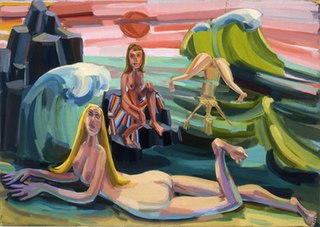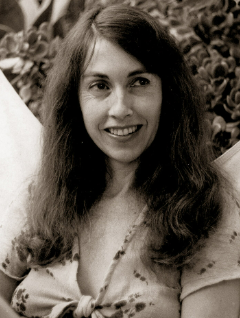
Hard-edge painting is painting in which abrupt transitions are found between color areas. Color areas often consist of one unvarying color. The Hard-edge painting style is related to Geometric abstraction, Op Art, Post-painterly Abstraction, and Color Field painting.

Vija Celmins is a Latvian American visual artist best known for photo-realistic paintings and drawings of natural environments and phenomena such as the ocean, spider webs, star fields, and rocks. Her earlier work included pop sculptures and monochromatic representational paintings. Based in New York City, she has been the subject of over forty solo exhibitions since 1965, and major retrospectives at the Museum of Modern Art, Whitney Museum of American Art, Los Angeles County Museum of Art, San Francisco Museum of Modern Art, Institute of Contemporary Arts, London and the Centre Pompidou, Paris.

The Orange County Museum of Art (OCMA) is a modern and contemporary art museum located on the campus of the Segerstrom Center for the Arts in Costa Mesa, California. The museum's collection comprises more than 4,500 objects, with a concentration on the art of California and the Pacific Rim from the early 20th century to present. Exhibits include traditional paintings, sculptures, and photography, as well as new media in the form of video, digital, and installation art.
Joe Goode, is an American visual artist, known for his pop art paintings. Goode made a name for himself in Los Angeles, California, through his cloud imagery and milk bottle paintings which were associated with the Pop Art movement. The artist is also closely associated with Light and Space, a West Coast art movement of the early 1960s. He resides in Los Angeles, California.
Elyse Pignolet is a visual artist living and working in Los Angeles, California.

Linda Levi is an American artist who lives and works in Los Angeles, California.
Idelle Lois Weber was an American artist most closely aligned with the Pop art and Photorealist movements.

Cora Cohen was an American artist whose works include paintings, drawings, photographs, and altered x-rays. Cohen is most known for her abstract paintings and is often identified as continuing the tradition of American Abstraction. In a 2023 review in Artforum Barry Schwabsky suggested that "Cohen’s determination to evade stylistic consistency has made her one of the most underrated painters in New York." The New York Times' critic Michael Brenson wrote of her 1984 exhibition, Portraits of Women: "The works are dense, brooding and yet elated. The turbulence of the paint not only looks but also feels like freedom." Cohen interviewed many other artists also associated with continuing the tradition of American Abstraction for Bomb Magazine including; Ralph Humphrey, Dona Nelson, Craig Fisher, Carl Ostendarp, and Joan Mitchell. Her work has also been identified with traditions of European abstraction, and specifically German abstraction, including the work of Wols, Sigmar Polke, Gerhard Richter. She began exhibiting in Germany in the early nineties and continued to show at some of its most prestigious institutions.

Katherine Bradford, née Houston, is an American artist based in New York City, known for figurative paintings, particularly of swimmers, that critics describe as simultaneously representational, abstract and metaphorical. She began her art career relatively late and has received her widest recognition in her seventies. Critic John Yau characterizes her work as independent of canon or genre dictates, open-ended in terms of process, and quirky in its humor and interior logic.

Judith Linhares is an American painter, known for her vibrant, expressive figurative and narrative paintings. She came of age and gained recognition in the Bay Area culture of the 1960s and 1970s and has been based in New York City since 1980. Curator Marcia Tucker featured her in the influential New Museum show, "'Bad' Painting" (1978), and in the 1984 Venice Biennale show, "Paradise Lost/Paradise Regained: American Visions of the New Decade." Linhares synthesizes influences including Expressionism, Bay Area Figuration, Mexican modern art and second-wave feminism, in work that flirts with abstraction and balances visionary personal imagery, expressive intensity, and pictorial rigor. Art historian Whitney Chadwick wrote, "Linhares is an artist for whom painting has always mattered as the surest path of synthesizing experience and interior life," her works "emerging as if by magic from an alchemical stew of vivid complementary hues and muted tonalities." Critic John Yau describes her paintings "funny, strange, and disconcerting," while writer Susan Morgan called them "unexpected and indelible" images exploring "an oddly sublime territory where exuberant bliss remains inseparable from ominous danger."
Elena Sisto is an American painter based in New York.
Sigrid Sandström is a Swedish artist and a professor of Painting at the Academy of Fine Arts in Helsinki. Her work is characterized by graphic abstraction, an embrace of color and difference in scale, and an array of techniques used to apply paint and other materials to canvas, ranging from cloths and rugs, to masking with tape, squeegee-ing and smearing, and collaging. She has also worked in film and video, most notably for her 2005 exhibition Her Black Flags at the Mills College Art Museum in Oakland, CA, and in sculpture and installation. Artforum critic Naomi Fry, reviewing a 2007 show at Edward Thorp Gallery, cited the artist's interest in landscape as subject and noted that Sandström "also grapples here with painting’s essential difficulty in the face of the sublime. As the works consistently teeter on the verge of abstraction, the interplay between a more traditional naturalism and geometric fragmentation provides a salient tension."

Ron Linden is a California abstract painter, independent curator, and associate professor of art at Los Angeles Harbor College, Wilmington. He lives and works in the San Pedro area of Los Angeles.

Suzanne Jackson is an American visual artist, gallery owner, poet, dancer, educator, and set designer; with a career spanning five decades. Her work has been exhibited in museums and galleries around the world. Since the late 1960s, Jackson has dedicated her life to studio art with additional participation in theatre, teaching, arts administration, community life, and social activism. Jackson's oeuvre includes poetry, dance, theater, costume design, paintings, prints, and drawings.

Martha Joanne Alf was an American artist. Her work consists of paintings, drawings and photographs of everyday objects, including pears and rolls of toilet paper.

Judith Murray is an American abstract painter based in New York City. Active since the 1970s, she has produced a wide-ranging, independent body of work while strictly adhering to idiosyncratic, self-imposed constants within her practice. Since 1975, she has limited herself to a primary palette of red, yellow, black and white paints—from which she mixes an infinite range of hues—and a near-square, horizontal format offset by a vertical bar painted along the right edge of the canvas; the bar serves as a visual foil for the rest of the work and acknowledges each painting’s boundary and status as an abstract object. Critic Lilly Wei describes Murray's work as "an extended soliloquy on how sensation, sensibility, and digressions can still be conveyed through paint" and how by embracing the factual world the "abstract artist can construct a supreme and sustaining fiction."
Libby Black is an American contemporary artist working primarily in drawing, painting, and sculpture. Black lives and works in Berkeley California.

Harriet Korman is an American abstract painter based in New York City, who first gained attention in the early 1970s. She is known for work that embraces improvisation and experimentation within a framework of self-imposed limitations that include simplicity of means, purity of color, and a strict rejection of allusion, illusion, naturalistic light and space, or other translations of reality. Writer John Yau describes Korman as "a pure abstract artist, one who doesn’t rely on a visual hook, cultural association, or anything that smacks of essentialization or the spiritual," a position he suggests few post-Warhol painters have taken. While Korman's work may suggest early twentieth-century abstraction, critics such as Roberta Smith locate its roots among a cohort of early-1970s women artists who sought to reinvent painting using strategies from Process Art, then most associated with sculpture, installation art and performance. Since the 1990s, critics and curators have championed this early work as unjustifiably neglected by a male-dominated 1970s art market and deserving of rediscovery.
Elizabeth Armstrong is an American curator of contemporary and modern art. Beginning in the late 1980s, she served in chief curatorial and leadership roles at the Walker Art Center, Museum of Contemporary Art, San Diego, Orange County Museum of Art (OCMA), Minneapolis Institute of Arts and Palm Springs Art Museum. She has organized numerous touring exhibitions and catalogues that gained national and international attention; among the best known are: "In the Spirit of Fluxus", "Ultrabaroque: Aspects of Post-Latin American Art", and "Birth of the Cool: California Art, Design, and Culture at Midcentury". She is also known for organizing three California Biennials (2002–6) and notable exhibitions of David Reed and Mary Heilmann. Armstrong's curatorial work and publications have been recognized by the Andy Warhol Foundation, the Center for Curatorial Leadership, the Getty Foundation Pacific Standard Time project and the National Endowment for the Arts, among other organizations.

Andrew Spence is an American artist known for abstract paintings that combine a minimalist vocabulary with playful references to the observed world. In the 1970s and 1980s, he gained recognition as one of a number of younger artists who were re-examining geometric modernism through a contemporary lens that invited humor and reference to everyday objects and life experience into the tradition. Spence's method of distilling visual phenomena into simple, emblematic images has been compared to Ellsworth Kelly, but his work has differed in its more even balance between abstraction and recognition, intuitive approach, and varied, expressive paint surfaces. Art in America critic Ken Johnson wrote that his work maintains "an ironic tension between lofty purism of modernist geometry and earth-bound ordinariness of the vernacular sources." In later paintings, Spence has increasingly obscured the original inspirations of his abstractions, in both form and titling. His work belongs to the permanent collections of the Metropolitan Museum of Art, Museum of Modern Art, and Whitney Museum of American Art, among others. He has received a Guggenheim Fellowship and awards from the American Academy of Arts and Letters and National Endowment for the Arts.
















